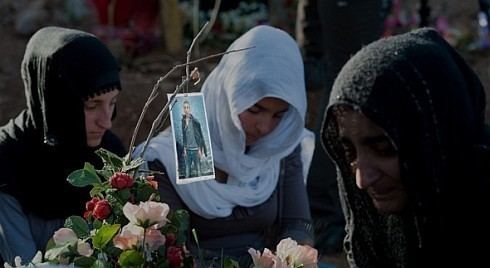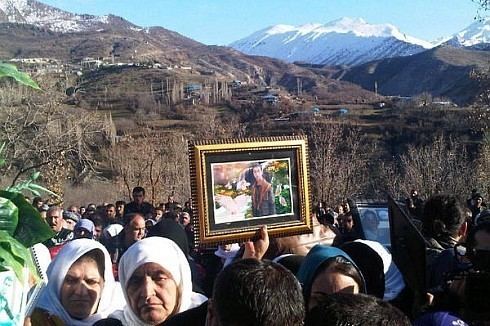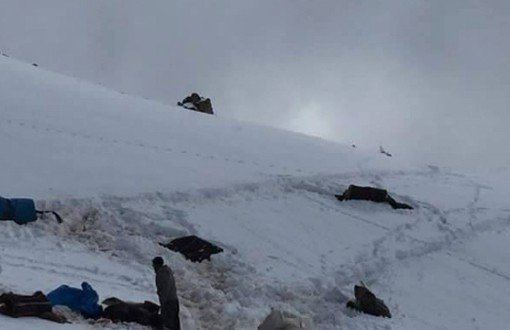Type Aerial attack Start date December 28, 2011 Number of casualties 34 | Target Kurdish smugglers Location Uludere, Turkey | |
 | ||
Executed by Turkish Air Force F-16 Fighting Falcon Similar Kurdish–Turkish conflict, Dersim rebellion, Halabja chemical attack, 1984 PKK attacks, 2011 Hakkâri attack | ||
The Uludere airstrike, also known as the Roboski massacre, Sirnak massacre, or Roboski massacre, took place on December 28, 2011, at 9:37 pm local time near the Turkish–Iraqi border. According to Turkish government sources, 34 smugglers were killed in the incident.
Contents
- Incident
- Funeral
- Protests
- Responses
- Public opinion
- Legal procedure
- Against officials involved
- Regarding civilians and families of the deceased
- References

Incident

A group of 40 Kurdish villagers of Turkish nationality, mostly teenagers, from the Ortasu (in Kurdish: Robozik) and Gülyazı villages in Uludere district of Şırnak Province were moving in the night of December 28, 2011 from Iraqi territory towards Turkish border. The people were on a tour for smuggling cigarettes, diesel oil and the like into Turkey, packed on mules.

Turkish Armed Forces had received certain information about activities at the region supplied by United States intelligence services that was based on a U.S. drone ten days before the incident. The footage by the unmanned aerial vehicles flying over the terrain was evaluated as a group of militants of the Kurdistan Workers' Party (PKK). Pentagon officials were quoted as saying that American drones initially spotted the group, but after alerting the Turks and offering to conduct more detailed surveillance they were denied and “Turkish officers instead directed the Americans who were remotely piloting the drone to fly it somewhere else.” The security forces had been criticized in the media for their failure and losses. Two F-16 Fighting Falcons of the Turkish Air Force took off and bombed the area.

The next morning, relatives searched for the missing people, and found the bodies of the victims. 34 people belonging to the group were killed during and shortly after the airstrike. Two smugglers escaped to Iraq. Only one survivor, Servet Encü, returned to his village. 28 of the dead were from the Encü family. The bodies, some of them burnt beyond recognition or dismembered, were transported to their hometown on mules due to the rough terrain.

Servet Encü stated that generations of people in his village and neighboring settlements have been in the smuggling business because they are financially in need. He added that Iraqi traders bring diesel oil or tea by their vehicles to within 2–3 km (1.2–1.9 mi) of the border, and the villagers buy the goods and bring them home on trails, which takes about two and half hours. He said that the smuggling action was well known to the security forces at the border.
Funeral
The funeral of the victims, following an autopsy performed in the Uludere hospital, took place at a newly established cemetery between the villages Ortasu and Gülyazı. The funeral convoy, formed by about 1,000 vehicles and attended by a crowd of about 10,000 people, covered the distance of 20 km (12 mi) between the district center and the cemetery in one hour.
Protests
Major protests followed in Turkey's predominantly Kurdish cities, most notably Diyarbakır where protests turned violent and police used batons and tear gas against protesters and protesters threw stones and Molotov cocktails at police. Protests were also held in Ankara and Istanbul, where over 1,000 protesters gathered in Taksim Square and threw stones at police and smashed vehicles before police dispersed the crowds with tear gas and water cannons.
District governor Naif Yavuz, who was from the beginning on together with the smugglers at the autopsy and the funeral service, paid later a visit to house of the relatives of the victims for condolence. Shortly after his visit, he was attacked by a mob, which attempted to lynch him. He barely escaped the attack with the help of his security guards, however, was hospitalized for his injuries. It turned out to be an act of people, who came outside the village.
In Nicosia, around 300 Kurds and Turkish Cypriots marched on the Turkish embassy in Northern Cyprus, where Murat Kanatlı, head of the left-wing New Cyprus Party spoke to the crowd and accused Turkey of escalating tensions in the South-East. The demonstration ended peacefully.
In Tehran, a group of Iranian Kurds demonstrated in front of the Turkish embassy in Iran.
In Arbil, some 500 Iraqi Kurds protested the killing, some of which clashed with Iraqi Kurdistan security forces, although no casualties were reported. Some protesters carried pictures of Abdullah Öcalan and chanted "fight, fight for freedom" and "Erdogan is a terrorist." At the protest, Kurdish activist Ali Mahmoud told the press that "The crime ... is a real genocide, a war crime and a crime against humanity, and breaches international laws, we demand that Turkey be judged in the international courts."
Responses
Public opinion
In a MetroPOLL survey which involved 1,174 people, when asked about who was ultimately responsible for the deaths, 14.5% of Turks said the state, 11.5% said the smugglers, 9.5% said the PKK, 5.4% said the prime minister of the government and 4.9% said it was the General Staff. When asked whether the government had fulfilled its responsibilities towards the incident, some 45% said yes, with 38.1% saying no.
Legal procedure
Legal procedure after the massacre includes:
Against officials involved
On 9 January 2012, the commander of the Gülyazı military border post near Roboski, Gendarmerie Colonel Hüseyin Onur Güney, was suspended from duty following a military investigation. 17 active duty army staff were also prosecuted for allowing border smuggling.
On 9 January 2012, a special commission to investigate the Uludere massacre has been established at the Turkish Grand National Assembly. During the hearings, opposition MPs complained that the Ministry of Defence denied answering questions using the confidentiality order taken by the prosecutors office as an excuse. On 22 March 2013, the commission submitted its 85-page report on the massacre which concludes that military operation ended with 34 civilian casualties was without deliberate intent. Three members of the commission from the opposition parties lodged a minute of dissent to the report, mainly criticising the lack of thorough investigation.
The criminal investigation has first been administered by the Diyarbakır State Prosecutor's Office, however, prosecutors admitted the documents they have demanded from the office of Chief of General Staff have been belated and military personnel has not been interrogated. Despite of the limitations, prosecutors were able to confirm on 6 August 2012 that the villagers were clearly discernible from the footage of the unmanned aerial vehicle taken before the massacre. Wall Street Journal reported that it was a U.S. drone that spotted the group on the Iraqi border. On 11 June 2013, the Diyarbakır Prosecutor's Office after investigating the case for more than 18 months has cited no deliberate intent by the military staff, but negligence, and hence declared lack of jurisdiction and transferred the investigation to the military prosecutor.
On 7 January 2014, military prosecutors (General Staff Military Prosecutor's Office) decided not to follow charges against the military personnel --nolle prosequi, citing that no investigation was necessary for suspected military staff İlhan Bölük, Yıldırım Güvenç, Aygün Eker, Halil Erkek and Ali Rıza Kuğu as “they committed a major error but performed their duties within the given orders”.
Previously on 23 May 2012, then Minister of Interior İdris Naim Şahin stated that the decision for the operation had been given at the air forces command centre in Ankara. On 7 January 2014, it was reported that the Chief of General Staff, Necdet Özel, has authorised the operation approximately 90 minutes before the first fire. Pro-Kurdish Peace and Democracy Party (BDP) had filed a lawsuit against the Turkish government at ICC following the massacre.
Regarding civilians and families of the deceased
5 persons were arrested for attempting to murder Uludere district governor Naif Yavuz on 9 January 2012.
On 16 January 2012, Roboski massacre survivors Davut, Servet and Hacı Encü testified for passport law abuse, illegal border-crossing and smuggling charges.
On 28 June 2012, NGO members and relatives of the deceased who intended to protest at the site of the massacre were subjected to police violence and were dispersed by the pressurised water cannons.
On 25 December 2012, police detained 19 individuals in and around Sirnak just four days before the anniversary of the massacre.
Among the relatives of the deceased, Ferhat Encü who has lost 11 relatives at the massacre, has been subject to continuous harassment by the police, reportedly taken into custody four times with the same charge.
